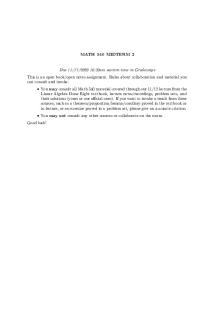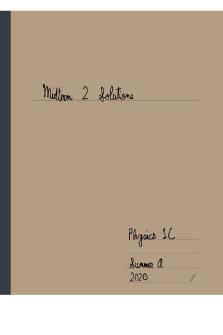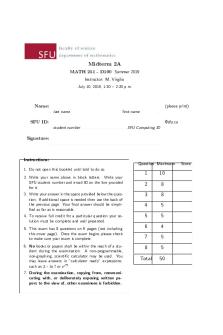Math 54 Spr14 Teleman Midterm 2 Solutions PDF

| Title | Math 54 Spr14 Teleman Midterm 2 Solutions |
|---|---|
| Author | Daniel Tang |
| Course | Asymptotic Analysis In Applied Mathematics |
| Institution | University of California, Berkeley |
| Pages | 4 |
| File Size | 89.2 KB |
| File Type | |
| Total Downloads | 45 |
| Total Views | 133 |
Summary
Download Math 54 Spr14 Teleman Midterm 2 Solutions PDF
Description
Question 1. (16 points) Choose the correct answers, worth 2 points each. No justification necessary. Incorrect answers carry a 2-point penalty, so random choices are not helpful. You may leave any question blank for 0 points. F
For two n × n matrices A, B, Det(A − B) = Det(A) − Det(B ).
F
Two similar matrices have exactly the same eigenvectors.
T
If the columns of a real 2 × 2 matrix M 6= I2 are orthonormal, then M is the matrix of a rotation or of a reflection in R2 .
T
If ku − vk = ku + vk, then u and v are orthogonal.
T
The columns of an n × n matrix S span Rn if and only if Det(S) 6= 0.
T
The transpose of an orthogonal matrix is also an orthogonal matrix.
T
The matrix representing the reflection about a line through 0 in R2 is always diagonalizable over the reals. F
The left nullspace of the square matrix A is non-zero if and only if 0 is not an eigenvalue of A. If A and B are orthogonal matrices of the same size, then AB −1 is an orthogonal matrix.
T F
If the columns of the matrix A are non-zero and pairwise orthogonal, then the system Ax = b must be consistent.
F
The determinant of a real, square matrix is equal to the product of its real eigenvalues, included with their multiplicities.
T
Similar matrices have the same characteristic polynomial.
Question 2. (18 points) Select the correct answer for each question, worth 3 points each. There is no penalty for incorrect answers (but, of course, you forfeit the points). Answer key: 1c, 2c, 3f, 4a, 5c, 6e, 7c, 8c, 9f 1. Under which circumstances is the square matrix A guaranteed to have non-zero determinant? (a) A has no zeroes on the diagonal
(b) A is the coefficient matrix of a consistent linear system
(c) The linear system Ax = 0 has a unique solution
(d) A has only positive entries
(e) A has orthogonal columns
(f) None of the above
2. We are told that the 4 × 4 real matrix A has exactly two distinct real eigenvalues, with multiplicity one each. We can safely conclude that (a) A is invertible
(b) A is diagonalizable over R
(c) A is diagonalizable over C
(d) A is symmetric
(e) A is orthogonal
(f) None of the above
3. If
1 2
ku + vk2 + ku − vk2 = kuk2 + kvk2 for two vectors u, v in Rn , we can conclude
(a) u and v are orthogonal (d) u, v are linearly dependent
(b) u = v = 0 (e) u, v must be vectors in R
1
(c) kuk = kvk 2
(f) Nothing: that is always true
2 1 is 4. In a new basis of R2 , the coordinate vector of the vector 2 3 5 Then, the coordinate vector of is 6 6 6 (a) (b) 7 8 5 7 (d) (e) 7 6
and that of the vector
(c)
3 4 is . 4 5
5 6
(f) Cannot be determined from the data
5. A least-squares solution ˆx of a (possibly inconsistent) m × n linear system Ax = b is characterized by (a) x ˆ is the shortest vector in Col(A)
(b) x ˆ is the orthogonal projection of b onto Col(A)
(c) x ˆ is in Rn and kAˆ x − bk is as short as possible
(d) x ˆ is in Col(A) and kˆx − bk is as short as possible
(e) Aˆ x is the orthogonal projection of b onto Row(A)
(f) A least squares solution may not exist so we cannot safely characterize it
6. Under which of the following assumptions is the real n × n matrix A guaranteed to be diagonalizable over the reals? (a) Row-reduction of A finds n distinct pivots
(b) A is an orthogonal matrix
(c) A has n distinct eigenvalues
(f) All eigenvalues of A are real (d) A has n real eigenvalues, (e) There are n linearly indepen- and there is at least one eigenvector for each dent real eigenvectors for A with multiplicities counted 7. Pick the matrix on the list which is NOT diagonalizable (not even over C), if any; else, pick option (f). 1 2 2 1 2 1 (a) (b) (c) 2 3 −1 1 −1 0 (f) All of them are diagonalizable 1 2 1 2 (d) (e) over R or C 0 3 −2 1 8. If A is an m × n matrix and B an n × m matrix, then Det(AB) = Det(BA), provided that the following additional condition holds: (select the least restrictive correct answer) (b) m = n and both A and B are (c) m = n (d) m = n and one of A, B is invertible (e) AB = BA (f) A and B are in echelon form invertible (a) Always, no condition needed
9. We are told that the real, square matrix A is diagonalizable over R. Pick the matrix from the list which is NOT guaranteed to be diagonalizable over R, if any; or else, pick option (f). (a) A2
(b) AT A
(c) A−1 , assuming A invertible
(d) AT
(e) A + I
(f) All of them are diagonalizable
2
Question 3. (17 points, 6+5+6) For the matrix A below, 1. Find its characteristic polynomial 2. Find its eigenvalues. (Note: there will be complex eigenvalues.) 3. Find a (non-zero) eigenvector for each eigenvalue. 3 −1 A = 5 −1 0 0 1.
3−t χA (t) = det 5 0
1 3 2
−1 1 3−t −1 = (2 − t)(t2 − 2t + 2) −1 − t 3 = (2 − t) · det 5 −1 − t 0 2−t
2. The roots of χA (t) are λ = 2 and µ± = 1 ± i. So A has one real and a pair of complex-conjugate, non-real eigenvalues. 0 3. For λ = 2, Nul(A − 2I3 ) is spanned by 1. For µ+ , we seek a non-zero complex vector w+ in 1 2−i −1 1 Nul 5 −2 − i 3 ; 0 0 1−i clearly we need the third entry of w+ to vanish, and the top two entries must verify w 2−i −1 · 1 =0 5 −2 − i w2 so w1 = 1, w2 = 2 − i will work and we can take w+ 1 conjugation, w− = 2 + i. 0
1 = 2 − i. We can get a w− by complex 0
Question 4. (14 points, 8+6)
1 1 1 −1 0 0 Let V ⊂ R4 be the span of the vectors 0 , −1 and 0 . 0 0 −1 (a) Use the Gram-Schmidt process on these vectors to produce an orthogonal basis of V . (b) Find the orthogonal projection of the vector [1, 0, 0, 1]T onto V . Explain your method. (a) We take u1 = [1, −1, 0, 0]T . Then, 1 1 1 1/2 0 1 −1 1/2 0 [1, 0, −1, 0] · u1 u2 = u1 = −1 − 2 0 = −1 −1 − ku1 k2 0 0 0 0 1 1 1 1/2 1/3 0 [1, 0, 0, −1] · u1 0 1 −1 1 1/2 1/3 [1, 0, 0, −1] · u2 u1 − u3 = u2 = 0 − 0 − 2 0 − 3 −1 = 1/3 . ku1 k2 ku2 k2 −1 −1 0 0 −1 3
(b) It is easier to project onto the orthogonal complement of V , which is the line spanned by a = [1, 1, 1, 1]T . ·a a = 21a, so the orthogonal projection of [1, 0, 0, 1]T The projection of [1, 0, 0, 1]T onto that line is [1,0k,a0k,1] 2 onto V is 1/2 1 0 1 − a = −1/2 −1/2 0 2 1/2 1
Question 5. (10 points) s1 Set up a consistent system of linear equations for the vector s = s2 , whose solution gives the best fit of s3 t -2 -1 0 1 2 the data points to the relation y = s1 t + s2 t2 + s3 t3 , in the sense of least squares. y 1 0 1 2 2 Explain your procedure, including what your solution is attempting to achieve. (You need not solve the system explicitly)
We are trying to solve the (inconsistent) system −2s1 + 4s2 − 8s3 = 1 −s1 + s2 − s3 = 0 0+0+0= 1 , s + s2 + s3 = 2 1 2s1 + 4s2 + 8s3 = 2
−2 −1 or 0 1 2
4 −8 1 0 1 −1 0 0 · s = 1 2 1 1 2 4 8
Calling A the 5 × 3 matrix and b the 5-component P vector of values, we want to find the least squares solution of this system, the one which minimizes the error 2t=−2 |y(t) − s1 t − s2 t2 − s3 t3 = kAs − bk2 . For this, As − b must be perpendicular to Col(A) and this condition is encoded by the normal equations AT As = AT b which in this case give
10 0 0 34 34 0
34 s1 4 0 · s2 = 14 130 s3 10
(The solution is s1 = 1.25, s2 = 7/17, s3 = −.25)
4...
Similar Free PDFs

Math 54 Midterm 2 Practice 4
- 8 Pages

Midterm 2-solutions
- 7 Pages

Practice Midterm 2 - Solutions
- 5 Pages

P1C Midterm 2 Solutions
- 12 Pages

Summer 2019 Midterm 2 Solutions
- 11 Pages

Math 114 Practice Midterm
- 9 Pages

Midterm MATH 133
- 4 Pages

Math 109 Practice Midterm I
- 11 Pages

METU Math 119 2015 Midterm
- 5 Pages

2020W2 midterm solutions
- 10 Pages

MATH 131 Midterm - Grade: A
- 4 Pages

Math 1012 Midterm 1 Review
- 5 Pages
Popular Institutions
- Tinajero National High School - Annex
- Politeknik Caltex Riau
- Yokohama City University
- SGT University
- University of Al-Qadisiyah
- Divine Word College of Vigan
- Techniek College Rotterdam
- Universidade de Santiago
- Universiti Teknologi MARA Cawangan Johor Kampus Pasir Gudang
- Poltekkes Kemenkes Yogyakarta
- Baguio City National High School
- Colegio san marcos
- preparatoria uno
- Centro de Bachillerato Tecnológico Industrial y de Servicios No. 107
- Dalian Maritime University
- Quang Trung Secondary School
- Colegio Tecnológico en Informática
- Corporación Regional de Educación Superior
- Grupo CEDVA
- Dar Al Uloom University
- Centro de Estudios Preuniversitarios de la Universidad Nacional de Ingeniería
- 上智大学
- Aakash International School, Nuna Majara
- San Felipe Neri Catholic School
- Kang Chiao International School - New Taipei City
- Misamis Occidental National High School
- Institución Educativa Escuela Normal Juan Ladrilleros
- Kolehiyo ng Pantukan
- Batanes State College
- Instituto Continental
- Sekolah Menengah Kejuruan Kesehatan Kaltara (Tarakan)
- Colegio de La Inmaculada Concepcion - Cebu



